
This is something that might well surprise you, as it did me. It’s to do with a fat in the coffee beans. However, different coffee preparation methods result in different amounts of this fat actually getting into your cup and eventually into your body.
A video 1 by Dr Greger covers this in more detail, with some historical reasons why this interesting phenomenon has not been well-known for some time; but I just want to pick out the salient points.
Blog Contents
Where’s the evidence?
Firstly, how do we really know that this is the case? Well, there’s plenty of research going back over decades 2 3 showing that, indeed, there’s no doubt about the fact that drinking coffee can increase serum concentration of total and low-density-lipoprotein cholesterol in humans, and that abstaining 4 from coffee-drinking reduces cholesterol levels. It doesn’t do the same for rats, hamsters or chimpanzees, interestingly enough; and that’s one of the reasons that animal tests didn’t throw up any worries about its potential cholesterol-raising effect on humans.
What’s the offending party?
The lipids (fats) causing the problem are called cafestol 5 (in particular) and also kahweol 6 . An ideal coffee preparation method would extract all the lipids before they found their way into the cup. However, no methods appear to do this, and some let a lot more through than others.
Different coffee preparation methods
So, researchers compared the different ways that coffee beans can be prepared. These are four of the main ones:
- boiled
- cafetiere (French filtered)
- paper-filtered
- instant (powder or granules)
Cafetiere
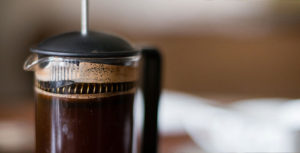
Various studies 7 8 show that preparing your coffee in a cafetiere (with its metal grid filter) is the least effective at removing the cholesterol-raising lipids. You can probably tell this from the fact that there’s always a bit of a slurry of coffee grains at the bottom of the cup, no matter how slowly you push down the filter knob.
The following chart 7 shows cholesterol levels gradually increase over weeks when consuming cafetiere-prepared coffee:
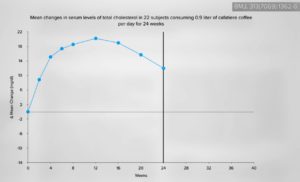
Boiled
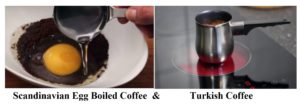
Scandinavian egg boiled coffee (yuk!) and Turkish coffee both boil the ground coffee and pour into a cup without any filter. It’s pretty clear that this type of preparation method is not going to get rid of the coffee grounds, and hence the lipids. Turkish coffee is prepared in a special special pot called a cezve, uses very finely ground beans and has sugar added while the water (and coffee grounds) are boiling. It appears to have slightly less cholesterol-raising effect than simply boiling the coffee grounds – with or without the egg.
Paper-filtered
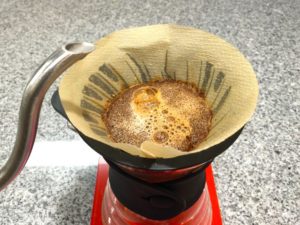
The above chart showed the effect of cafetiere coffee. The following chart is a continuation of the latter from the same study 7 once the subjects had changed to paper filtered coffee. You will see that their cholesterol dropped down significantly:
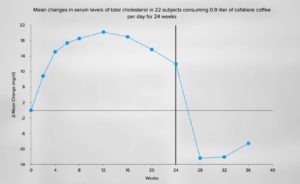
Don’t get too excited and rush out to buy a paper filter coffee maker just yet. Studies 9 show that using a paper filter still results in raised cholesterol (compared with abstaining altogether); however, it’s a more effective method for removing the lipids than simply boiling or using a cafetiere. Why so? Pretty obvious really, as studies 10 have shown: the paper retains much of the grounds and hence the lipids; or, in the words of the researchers themselves: “…one can conclude that the greater part of the coffee cafestol is retained by the spent coffee, due to the low extraction of the lipid fraction by the hot water.”
Instant
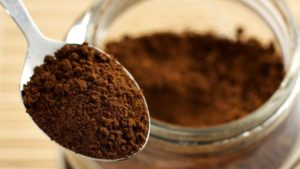
Instant coffee retains around the same amount of lipids as paper-filtering. Not as bad as the other methods, then.
Methods visually compared
The following is a chart from Dr Greger’s video which shows a range of coffee preparation methods and how much cafestol is retained by each:
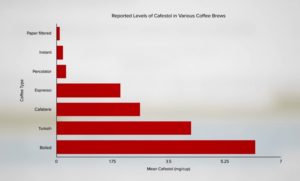
You’ll see that paper-filtered and instant coffee are most effective, but percolated is also pretty good, at least when compared with the likes of espresso, cafetiere, Turkish and boiled.
Final thoughts
If you have high cholesterol, it’s probably a good idea to cut out coffee for a while and have your cholesterol levels rechecked – even if you eat an otherwise really healthy diet. I say this because one of the studies 9 clearly showed that LDL cholesterol is raised by any coffee consumption, even paper-filtered coffee, as can be seen from a graph from the latter study, which shows a significant increase in LDL after only a month of drinking just paper-filtered coffee:
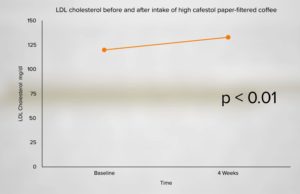
Apparently, darker roasts have less cafestol, according to at least one study8 . For my part, I’m going to switch from my usual cafetiere to using a good quality instant. In fact, I’ll probably start replacing my coffee with green tea – at least some of the time…
References
- Does Coffee Affect Cholesterol? Michael Greger M.D. FACLM August 27th, 2018 Volume 43 [↩]
- Urgert R, Katan MB. The cholesterol-raising factor from coffee beans. Annu Rev Nutr. 1997;17:305-24. [↩]
- Fried RE, Levine DM, Kwiterovich PO, et al. The effect of filtered-coffee consumption on plasma lipid levels. Results of a randomized clinical trial. JAMA. 1992;267(6):811-5. [↩]
- Christensen B, Mosdol A, Retterstol L, Landaas S, Thelle DS. Abstention from filtered coffee reduces the concentrations of plasma homocysteine and serum cholesterol–a randomized controlled trial. Am J Clin Nutr. 2001;74(3):302-7. [↩]
- Cafestol: Definition on Wikipedia [↩]
- Kahweol: Definition on Wikipedia [↩]
- Urgert R, Meyboom S, Kuilman M, et al. Comparison of effect of cafetière and filtered coffee on serum concentrations of liver aminotransferases and lipids: six month randomised controlled trial. BMJ. 1996;313(7069):1362-6. [↩] [↩] [↩]
- Zhang C, Linforth R, Fisk ID. Cafestol extraction yield from different coffee brew mechanisms. Food Res Internat. 2012;49:27-31. [↩] [↩]
- Corrêa TA, Rogero MM, Mioto BM, et al. Paper-filtered coffee increases cholesterol and inflammation biomarkers independent of roasting degree: a clinical trial. Nutrition. 2013;29(7-8):977-81. [↩] [↩]
- Rendón MY, Dos santos scholz MB, Bragagnolo N. Is cafestol retained on the paper filter in the preparation of filter coffee?. Food Res Int. 2017;100(Pt 1):798-803. [↩]